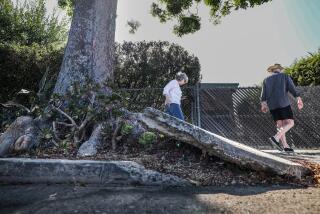Opinion: In praise of the ugly, concrete-encased but safely tamed Los Angeles River
To the editor: I have lived four blocks from the Los Angeles River for more than 40 years. (“Paving the Los Angeles River wasn’t an egalitarian idea. The plan for revitalizing it should be,” Opinion, Jan. 4)
I know from working the soil in my backyard that the river was not always that far away. The clay-like soil and gravel deposits remind us that the river once reached my property during the rainy seasons. As new owners 40-something years ago, my husband and I listened to an elderly neighbor reminisce about our land having been good only for keeping horses.
I benefit daily from the concrete walls built to retain the river when I walk along the Los Angeles River Greenway. I have seen during severe rains how close the raging water comes to topping those concrete banks. Without the barriers, many homes, businesses and roads would be inundated regularly or washed away.
Are those who question why the riverbed was encased in concrete saying we should not have built our homes, businesses, roads and freeways so near the river? Should the Los Angeles River just run free?
Ila Tanchuk, Sherman Oaks
..
To the editor: Historian William Deverell leaves readers believing that the channelization of the L.A. River was some sort of nefarious plot to harm the poor and benefit the “Anglo elites” of the 1930s.
He ignores the historical flooding pattern that caused the effort to be undertaken. The river flooded not the properties of the wealthy nor of the business community, but the truck gardens and the properties of lower socioeconomic communities. These communities were heavily populated by African Americans and people of Japanese ancestry.
I grew up in southwest Los Angeles, and even after the river had been largely controlled, flooding in Gardena, Watts and Willowbrook often blocked highways during heavy storms. Prior to the riverbed’s encasing, members of these communities literally had to “run for the hills” during storms.
While the concrete monstrosity is a symbol of a mistaken approach to environmental control, it was not built for “class” reasons.
Glen Mowrer, Santa Barbara
Follow the Opinion section on Twitter @latimesopinion and Facebook
More to Read
A cure for the common opinion
Get thought-provoking perspectives with our weekly newsletter.
You may occasionally receive promotional content from the Los Angeles Times.










